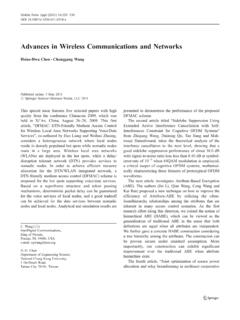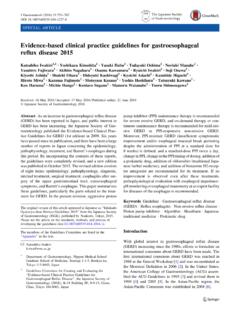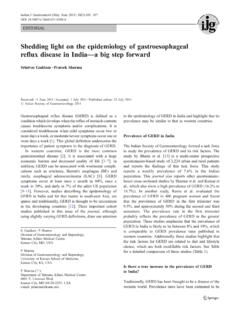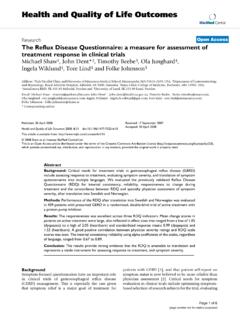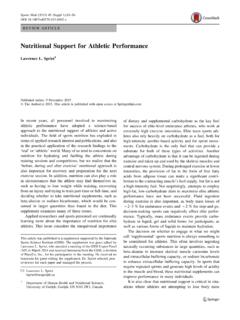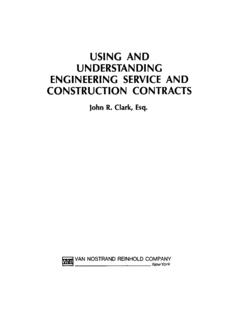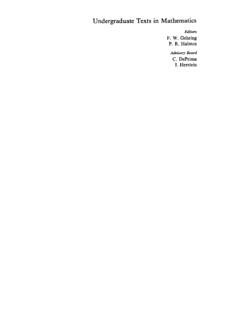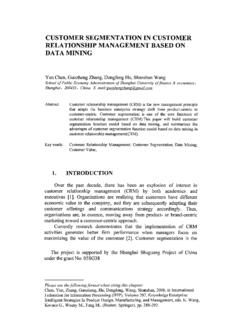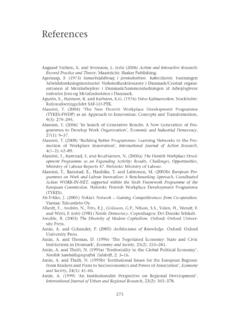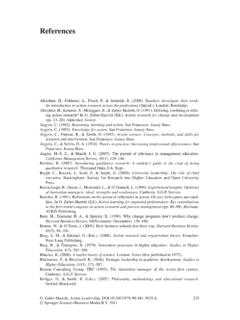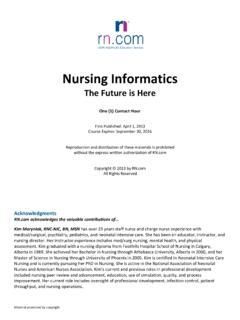Transcription of Burnout in nursing: a theoretical review - Springer
1 REVIEWOpen AccessBurnout in nursing : a theoretical reviewChiara Dall Ora1*, Jane Ball2, Maria Reinius2and Peter Griffiths1,2 AbstractBackground:Workforce studies often identify Burnout as a nursing outcome . Yet, Burnout itself what constitutesit, what factors contribute to its development, and what the wider consequences are for individuals, organisations,or their patients is rarely made explicit. We aimed to provide a comprehensive summary of research thatexamines theorised relationships between Burnout and other variables, in order to determine what is known (andnot known) about the causes and consequences of Burnout in nursing , and how this relates to theories of :We searched MEDLINE, CINAHL, and PsycINFO. We included quantitative primary empirical studies(published in English) which examined associations between Burnout and work-related factors in the :Ninety-one papers were identified.
2 The majority (n= 87) were cross-sectional studies; 39 studies used allthree subscales of the Maslach Burnout Inventory (MBI) Scale to measure Burnout . As hypothesised by Maslach, weidentified high workload, value incongruence, low control over the job, low decision latitude, poor social climate/social support, and low rewards as predictors of Burnout . Maslach suggested that turnover, sickness absence, andgeneral health were effects of Burnout ; however, we identified relationships only with general health and sicknessabsence. Other factors that were classified as predictors of Burnout in the nursing literature were low/inadequatenurse staffing levels, 12-h shifts, low schedule flexibility, time pressure, high job and psychological demands, lowtask variety, role conflict, low autonomy, negative nurse-physician relationship, poor supervisor/leader support, poorleadership, negative team relationship, and job insecurity.
3 Among the outcomes of Burnout , we found reduced jobperformance, poor quality of care, poor patient safety, adverse events, patient negative experience, medicationerrors, infections, patient falls, and intention to :The patterns identified by these studies consistently show that adverse job characteristics highworkload, low staffing levels, long shifts, and low control are associated with Burnout in nursing . The potentialconsequences for staff and patients are severe. The literature on Burnout in nursing partly supports Maslach stheory, but some areas are insufficiently tested, in particular, the association between Burnout and turnover, andrelationships were found for some MBI dimensions : Burnout , nursing , Maslach Burnout Inventory, Job demands, Practice environment The Author(s).
4 2020 Open AccessThis article is licensed under a Creative Commons Attribution International License,which permits use, sharing, adaptation, distribution and reproduction in any medium or format, as long as you giveappropriate credit to the original author(s) and the source, provide a link to the Creative Commons licence, and indicate ifchanges were made. The images or other third party material in this article are included in the article's Creative Commonslicence, unless indicated otherwise in a credit line to the material. If material is not included in the article's Creative Commonslicence and your intended use is not permitted by statutory regulation or exceeds the permitted use, you will need to obtainpermission directly from the copyright holder. To view a copy of this licence, Creative Commons Public Domain Dedication waiver ( ) applies to thedata made available in this article, unless otherwise stated in a credit line to the data.
5 * of Health Sciences, and Applied Research Collaboration Wessex,Highfield Campus, University of Southampton, Southampton SO17 1BJ, UKFull list of author information is available at the end of the articleDall (2020) 18:41 past decades have seen a growing research andpolicy interest around how work organisation character-istics impact upon different outcomes in nursing . Severalstudies and reviews have considered relationships be-tween work organisation variables and outcomes such asquality of care, patient safety, sickness absence, turnover,and job dissatisfaction [1 4]. Burnout is often identifiedas a nursing outcome in workforce studies that seek tounderstand the effect of context and inputs onoutcomes in health care environments. Yet, Burnout it-self what constitutes it, what factors contribute to itsdevelopment, and what the wider consequences are forindividuals, organisations, or their patients is not al-ways elucidated in these termburnoutwas introduced by Freudenberger in1974 when he observed a loss of motivation and reducedcommitment among volunteers at a mental health clinic[5].
6 It was Maslach who developed a scale, the MaslachBurnout Inventory (MBI), which internationally is themost widely used instrument to measure Burnout [6].According to Maslach s conceptualisation, Burnout is aresponse to excessive stress at work, which is charac-terised by feelings of being emotionally drained andlacking emotional resources Emotional Exhaustion; bya negative and detached response to other people andloss of idealism Depersonalisation; and by a decline infeelings of competence and performance at work re-duced Personal Accomplishment [7].Maslach theorised that Burnout is a state, which occursas a result of a prolonged mismatch between a person andat least one of the following six dimensions of work [7 9]:1) Workload: excessive workload and demands, so thatrecovery cannot be ) Control: employees do not have sufficient controlover the resources needed to complete oraccomplish their ) Reward: lack of adequate reward for the job can be financial, social, and intrinsic ( pride one may experience when doing a job).
7 4) Community: employees do not perceive a sense ofpositive connections with their colleagues andmanagers, leading to frustration and reducing thelikelihood of social ) Fairness: a person perceiving unfairness at theworkplace, including inequity of workload and ) Values: employees feeling constrained by their jobto act against their own values and their aspirationor when they experience conflicts between theorganisation s theorised these six work characteristics asfactors causing Burnout and placed deterioration inemployees health and job performance as outcomesarising from Burnout [7].Subsequent models of Burnout differ from Maslach sin one of two ways: they do not conceptualise burnoutas an exclusively work-related syndrome; they viewburnout as a process rather than a state [10].
8 The job resources-demands model [11] builds on theview of Burnout as a work-based mismatch but differsfrom Maslach s model in that it posits that Burnout de-velops via two separate pathways: excessive job demandsleading to exhaustion, and insufficient job resourcesleading to disengagement. Along with Maslach andSchaufeli, this model sees Burnout as the negative poleof a continuum of employee s well-being, with work en-gagement as the positive pole [12].Among those who regard Burnout as a process,Cherniss used a longitudinal approach to investigate thedevelopment of Burnout in early career human servicesworkers. Burnout is presented as a process characterisedby negative changes in attitudes and behaviours towardsclients that occur over time, often associated withworkers disillusionment about the ideals that had ledthem to the job [13].
9 Gustavsson and colleagues usedthis model in examining longitudinal data on early car-eer nurses and found that exhaustion was a first phasein the Burnout process, proceeding further only if nursespresent dysfunctional coping ( cynicism and disen-gagement) [14].Shirom and colleagues suggested that Burnout occurswhen individuals exhaust their resources due to long-term exposures to emotionally demanding circumstancesin both work and life settings, suggesting that Burnout isnot exclusively an occupational syndrome [15, 16].This review aims to identify research that has exam-ined theorised relationships with Burnout , in order todetermine what is known (and not known) about thefactors associated with Burnout in nursing and to deter-mine the extent to which studies have been underpinnedby, and/or have supported or refuted, theories was a theoretical review conducted according tothe methodology outlined by Campbell et al.
10 And Pareet al. [17, 18]. theoretical reviews draw on empiricalstudies to understand a concept from a theoretical per-spective and highlight knowledge gaps. theoretical re-views are systematic in terms of searching andinclusion/exclusion criteria and do not include a formalappraisal of quality. They have been previously used innursing, but not focussing on Burnout [19]. While noreporting guideline for theoretical reviews currently ex-ists, the PRISMA-ScR was deemed to be suitable, withDall (2020) 18:41 Page 2 of 17some modifications, to enhance the transparency ofreporting for the purposes of this review . The checklist,which can be found as Additional file2, has been modi-fied as follows: Checklist title has been modified to indicate that thechecklist has been adapted for theoretical reviews.
